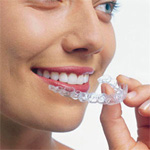Canyon Country: (661) 251-7107
Valencia Office: (661) 702-1582
Santa Clarita Orthodontics
"Creating Beautiful, Healthy Smiles That Last a Lifetime"
- Canyon Country Office:
- 18909 Soledad Rd.
- Unit G
- Canyon Country, CA 91351
- Santa Clarita Office:
- 28212 Kelly Johnson Pkwy.
- Suite 260
- Santa Clarita, CA 91355
Common Problems
Crossbite |
Orthodontics for Children
Early Treatment
When is the best time to begin orthodontics?
Though an orthodontist can enhance a smile at any age, there is an optimal time period to begin treatment. Beginning treatment at this time ensures the greatest result and the least amount of time and expense. The American Association of Orthodontists recommends that the initial orthodontic evaluation should occur at the first sign of orthodontic problems or no later than age 7. At this early age, orthodontic treatment may not be necessary, but vigilant examination can anticipate the most advantageous time to begin treatment.
What are the benefits of early orthodontic evaluation?
Early evaluation provides both timely detection of problems and greater opportunity for more effective treatment. Prudent intervention guides growth and development, preventing serious problems later. When orthodontic intervention is not necessary, an orthodontist can carefully monitor growth and development and begin treatment when it is ideal.
Why is age 7 considered the optimal time for screening?
By the age of 7, the first adult molars erupt, establishing the back bite. During this time, an orthodontist can evaluate front-to-back and side-to-side tooth relationships. For example, the presence of erupting incisors can indicate possible overbite, open bite, crowding or gummy smiles. Timely screening increases the chances for an incredible smile.
What are the advantages of interceptive treatment?
Some of the most direct results of interceptive treatment are:
- Creating room for crowded, erupting teeth
- Creating facial symmetry through influencing jaw growth
- Reducing the risk of trauma to protruding front teeth
- Preserving space for unerupted teeth
- Reducing the need for tooth removal
- Reducing treatment time with braces
Are you a candidate for orthodontic treatment?
Orthodontics is not merely for improving the aesthetics of the smile; orthodontic treatment improves bad bites (malocclusions). Malocclusions occur as a result of tooth or jaw misalignment. Malocclusions affect the way you smile, chew, clean your teeth or feel about your smile.
Why should malocclusions be treated?
According to studies by the American Association of Orthodontists, untreated malocclusions can result in a variety of problems. Crowded teeth are more difficult to properly brush and floss, which may contribute to tooth decay and/or gum disease. Protruding teeth are more susceptible to accidental chipping. Crossbites can result in unfavorable growth and uneven tooth wear. Openbites can result in tongue-thrusting habits and speech impediments. Ultimately, orthodontics does more than make a pretty smile—it creates a healthier you.
Retention
When we remove your braces, we will begin the retention stage of your treatment. The retention phase lasts for a lifetime. Your final orthodontic result depends on your retainers, so follow through with the hard work you’ve put in so far. Remember to remove your retainer before brushing, and brush your retainer before placing it back in your mouth.
Removable Retainers
Maxillary wrap-around retainers are your upper retainers, which are removable. You must be very careful when handling your upper retainers, as they are fragile and costly to replace. You are given a special case for your retainer; please make sure you keep them in this case when not wearing it! To clean these retainers, brush them with toothpaste (sometimes with denture cleaner) using warm water.
Your retainers should be worn at all times with the exception of eating and brushing your teeth. Your retainer should also be removed when participating in sports that require a mouthguard or while swimming. After 12 months of full-time wear, we may revise your retention treatment, allowing the retainer to strictly be worn at night.
Your final orthodontic result depends on your retainers, so follow through with the hard work you’ve put in so far.
Orthognathic Surgery
Corrective jaw surgery (orthognathic surgery) treats and corrects abnormalities of the facial bones, specifically the jaws and the teeth. Often, these abnormalities cause difficulty associated with chewing, talking, sleeping and other routine activities. Orthognathic surgery corrects these problems and, in conjunction with orthodontic treatment, will improve the overall appearance of the facial profile.
Using the latest in digital imaging technology, we will demonstrate the overall functional and aesthetic benefits of orthognathic surgery. Computerized treatment planning minimizes treatment times, recovery periods and the overall efficacy of your surgery. State-of-the-art materials such as titanium plates and miniature screws provide stability, strength and predictability to your treatment. These advances in technology, procedures and equipment reduce post-surgical recovery time, thus allowing patients to return to their normal routines soon after the surgery.
If you have additional questions, please call our Canyon Country office at (661) 251-7107, or our Valencia Office at (661) 702-1582, or contact us via email.









